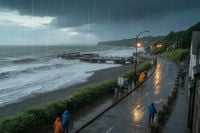Britain and the Netherlands are facing the brunt of Storm Benjamin, a powerful weather system named by Meteo France, which has swept across Western Europe bringing fierce winds, torrential rain, and widespread disruption. As of Thursday, October 23, 2025, the UK Met Office had issued four yellow weather warnings, with similar alerts from the Royal Netherlands Meteorological Institute (KNMI) for the Dutch coast and western provinces. The storm’s unpredictable path and intensity left authorities urging the public to stay informed and prepare for the worst.
In the UK, the warnings covered vast areas: southern England, the East Midlands, parts of Wales, and Yorkshire were under rain alerts from midnight until 6pm, with some areas facing up to 90mm (about four inches) of rainfall—enough to cause significant flooding. East Anglia and Lincolnshire remained under a rain warning until 9pm. Meanwhile, strong winds battered southeast England from 3am to midnight, with gusts widely reaching 50-60mph and peaking at 70mph along coastal regions. Cornwall, Devon, and the west coast of Wales were also under a wind warning from 6am to 3pm, with exposed coasts bracing for 55mph gusts.
According to Sky News, the Met Office warned that flooding, power cuts, and travel disruption were all possible, and that damage to buildings could not be ruled out. In fact, there was “a small chance of injuries and danger to life being caused by large waves” as the storm tracked from the English Channel to the North Sea. Coastal residents were urged to check their properties and “consider preparing a flood plan.”
Chief meteorologist Rebekah Hicks underscored the challenges facing forecasters: “It is worth noting that there is a greater than usual uncertainty surrounding the track and intensity of this low pressure system. The public should stay up to date with the latest forecasts and warnings as the situation evolves, with adjustments to the forecasts likely at short notice.”
The severity of the storm prompted the Met Office to advise those living in rain-prone areas to assemble an emergency kit, in case homes or businesses were flooded. Isolated locations in the East of England, such as remote parts of Norfolk and Lincolnshire, were at risk of receiving the heaviest deluge. The agency stated: “Totals are expected to widely reach 20-30mm within the warning area, with some places seeing 30-50mm. There is also a very low chance of a more developed system bringing very isolated rainfall totals of 60-90mm.”
Travel chaos was a real concern, especially as roadways and railways faced the double threat of flooding and high winds. The Met Office warned of “spray and flooding on roads leading to difficult driving conditions and increased chance of accidents, making journey times longer.” Public transport was expected to be disrupted, and authorities cautioned drivers—especially those operating empty trucks or large vehicles—to maintain greater distances and drive with care.
On the continent, the Netherlands was equally on high alert. The KNMI issued Code Orange warnings for Zeeland, Zuid-Holland, and Noord-Holland, with wind gusts expected to reach up to 120 kilometers per hour (about 75mph). Code Yellow warnings were in effect for inland and northern provinces, where gusts could hit 80-90 kilometers per hour. Rijkswaterstaat, the Dutch national highway authority, postponed planned roadworks and urged motorists to exercise extra caution, particularly from Thursday evening onward.
Rail travel in the Netherlands was also threatened. ProRail, the Dutch railway management firm, predicted potential problems beginning Thursday afternoon and advised passengers to monitor weather forecasts and journey planners, and to consider departing earlier if possible. Dutch rail operator NS said train schedules would remain unchanged unless a tree fell on the tracks, while KLM, the national airline, expected no impact on flights for Thursday but anticipated possible disruption on Friday as the storm lingered. “We do not expect any impact on our operations tomorrow (23 October), as the wind is forecast to pick up only later in the evening. We are closely monitoring the situation. For Friday (24 October), we anticipate that the weather may have a greater impact. As soon as there is more clarity, we will inform our passengers accordingly,” a KLM spokesperson told NL Times.
Authorities in the Netherlands also considered deploying the Hollandsche IJsselkering flood barrier, depending on the storm’s evolving impact. The storm was expected to spread from the southwest across the country overnight, gradually subsiding on Friday, with the Wadden Islands the last to be affected. KNMI anticipated downgrading the code orange alerts to yellow by Friday afternoon, with all warnings lifted by 1 p.m.
Back in the UK, the Met Office’s advice was practical: secure loose items outside the home—bins, garden furniture, trampolines, tents, sheds, and fences—to minimize the risk of injury or property damage from flying debris. Deputy chief meteorologist Dan Harris explained, “Low pressure moving across the south of the UK on Thursday will bring both a spell of heavy rain and areas of strong winds.” The agency warned that “conditions are likely to improve here however, at least for a time, during Thursday morning. As Storm Benjamin then moves across the southeast of England, stronger northeast to northwest winds are likely to develop.”
The storm’s impact stretched beyond meteorological concerns. According to BBC, two European football matches in the Netherlands were rescheduled to earlier times on Thursday to avoid the worst of the weather. Feyenoord’s Europa League clash with Greece’s Panathinaikos in Rotterdam was brought forward by over two hours, while AZ Alkmaar’s Conference League match with ŠK Slovan Bratislava was also rescheduled. The need for such adjustments underscored the seriousness of the storm’s threat to public events and infrastructure.
Storm Benjamin’s naming itself was a point of interest. While the Met Office did not consider the system severe enough to name, Meteo France took the lead after forecasting severe impacts for northern and western France. Once a European national meteorological agency names a storm, all nations in the region adopt the same name for clarity and consistency in communication—a practice that proved crucial as warnings and impacts crossed borders.
Looking ahead, the UK’s five-day forecast suggested that the worst would pass by Friday, with winds easing and rain clearing to sunshine and showers. However, colder temperatures and scattered showers—some wintry over the Scottish mountains—were expected over the weekend, providing little immediate relief for those cleaning up after the storm.
As Storm Benjamin battered Western Europe, officials and forecasters alike emphasized vigilance, preparation, and adaptability. With the storm’s unpredictable nature and potential for rapid escalation, communities across the UK and the Netherlands were reminded of the power of nature and the importance of heeding expert warnings.



